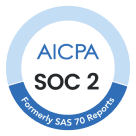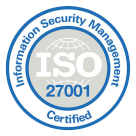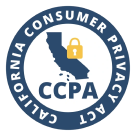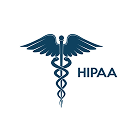What to Prioritize in Insurance Agency Call Centers: Key Features for Efficiency & Compliance

It’s 9:15 AM when Sarah, an insurance claims manager, gets the alert: Call wait times have spiked to 12 minutes.
Why? Two agents called in sick, call recordings aren’t syncing to the CRM, and there’s a growing backlog of customer inquiries about a recent policy update.
Meanwhile, her call center agents are juggling multiple systems just to handle basic claims processing.
Sarah’s situation isn’t unique. Insurance call centers face constant pressure to deliver fast, personalized service while navigating strict compliance rules, extensive documentation, and the risk of costly errors.
Without the right tools, inefficiencies pile up, frustrating both agents and customers.
But the right call center features can transform these challenges into opportunities. In this article, you’ll discover essential features to streamline claims processing, reduce handle times, and increase efficiency by 83.3%.*
Whether you’re evaluating your current setup or planning an upgrade, you’ll learn exactly what to prioritize for maximum ROI in the insurance industry.
Key Takeaways:
- Traditional insurance call centers face a triple challenge of long wait times, compliance vulnerabilities, and fragmented customer data, which diminishes service quality while increasing operational risk.
- CloudTalk’s integrated platform offers a comprehensive solution with Intelligent Routing, AI-powered Analytics, and robust security features.
- With the right technology, you can transform efficiency, compliance, and customer satisfaction—without additional staffing or extensive agent retraining.
Run a smarter call center
Identifying Gaps in Your Current Call Center Setup
Before Sarah could fix her call center agents’ mounting issues, she needed to pinpoint exactly where her current call center solution was falling short.
Like many insurance companies, though, the real problems weren’t immediately obvious—only the symptoms of long wait times and frustrated agents.
Let’s examine the three critical areas where traditional insurance call centers often struggle:
Signs Your Call Center Is Holding Back Operational Efficiency
Here are the key signals indicating your insurance call center needs an upgrade:
Excessive wait times and call abandonment
When customers face long wait times, they often abandon calls entirely. These abandoned customer support calls typically lead to follow-up attempts, resulting in additional strain and further frustrating customers.
Information access bottlenecks
Without immediate visibility into customer history, agents must piece together information from multiple systems or ask for information the caller previously provided. This frustrates customers and significantly extends call handling times.
Inefficient call routing
Poor call routing creates a mismatch between customer support needs and agent expertise. Claims specialists end up handling basic policy questions while complex cases get routed to general agents. This leads to unnecessary transfers, longer resolution times, and underutilized specialist expertise.
Performance tracking challenges
Without integrated analytics, tracking key metrics becomes a manual and often inaccurate process. The lack of clear performance data means you’re often making operational decisions based on incomplete information rather than actionable insights.
Compliance Risks That Could Put Your Agency at Risk
Compliance gaps aren’t just operational headaches—they represent existential threats to your organization. Here are the five compliance vulnerabilities that demand immediate attention:
Storing customer data
Weak encryption or unsecured data transfers can expose customer records, leaving agencies vulnerable to compliance fines, lawsuits, and breaches costing millions of dollars per incident. Even a single lapse can erode trust and trigger regulatory scrutiny.
Inadequate call recording policies
Many agencies either record too much (creating privacy concerns) or too little (causing critical documentation to be missing). Finding the right balance requires carefully structured policies based on industry standards and consistent consent mechanisms.
Lack of real-time monitoring
By the time compliance violations are discovered during random audits, the damage is already done. Real-time monitoring tools can flag problematic conversations as they happen, enabling supervisors to intervene before violations escalate.
Outdated systems
Legacy call center systems often lack the comprehensive logging and modern encryption standards required by regulations. These technical limitations create blind spots, which makes demonstrating compliance nearly impossible during regulatory reviews.
Poorly trained agents
Even perfect systems can’t overcome human error. Without ongoing compliance training and guided conversation workflows, agents may inadvertently make unauthorized guarantees or fail to provide required disclosures. This can create significant liability exposure.
Evaluating Your Tech Stack: Where Integrations and Automation Matter
After compliance, you need to check how well your systems connect. A fragmented tech stack slows down agents, irritates customers, and blocks performance tracking. Common gaps include:
Disconnected CRM systems
When your call center operates separately from your CRM platform, agents lose time searching for customer history. This disconnection forces customers to repeatedly provide the same information.
Manual data transfer
Without proper integration capabilities, your call center agents spend a large portion of their time on low-value data entry tasks. This manual transfer wastes productive hours and can increase errors that lead to compliance issues.
Siloed communication channels
Customers expect seamless transitions between voice calls, text messages, and digital communication. When these channels don’t connect, conversations break apart and customers have to repeat themselves across touchpoints.
Limited automation capabilities
Insurance workflows are full of repetitive tasks that don’t need human judgment. Without automation for scheduling, status updates, or payment reminders, your agents waste time on admin work instead of focusing on customer needs.
Restricted performance visibility
When call data isn’t linked to business outcomes, managers can’t see which agent actions affect retention, cross-selling, or lifetime value.
Essential Call Center Features for Insurance Agencies
Having identified the gaps in her operation, Sarah knew finding the right technology wasn’t just about fixing problems—she needed a proactive approach to optimizing her team.
Today’s insurance contact centers, whether in-house or outsourced, need focused solutions that directly address efficiency bottlenecks, compliance risks, and integration challenges.
The following features deliver measurable improvements in agent productivity, customer satisfaction, and security:
Intelligent Call Routing to Reduce Wait Times and Improve Accuracy
Traditional routing leaves specialists underutilized while creating bottlenecks with mismatched calls. Intelligent call routing transforms this process by directing each policyholder to the right agent based on their specific needs and history.
CloudTalk’s Intelligent Call Routing automatically routes callers to agents based on their skills and areas of expertise, significantly improving first-call resolution.
The system imports contact data from CRMs and databases, creating the seamless experience insurance customers expect while eliminating the frustration of repeating information.
This helps you reduce manual transfers, decrease handle times, and boost agent productivity.
McKinsey partner Julian Raabe points out that resolving customer issues efficiently isn’t about spending more time on each call but about understanding their needs upfront.
She says:
There’s no correlation between higher resolution and higher handle time. Actually, what we see is that it is much more important to really understand what matters to the customer. And this way, you can do it in a short or a proper period of time.”
Julian Raabe
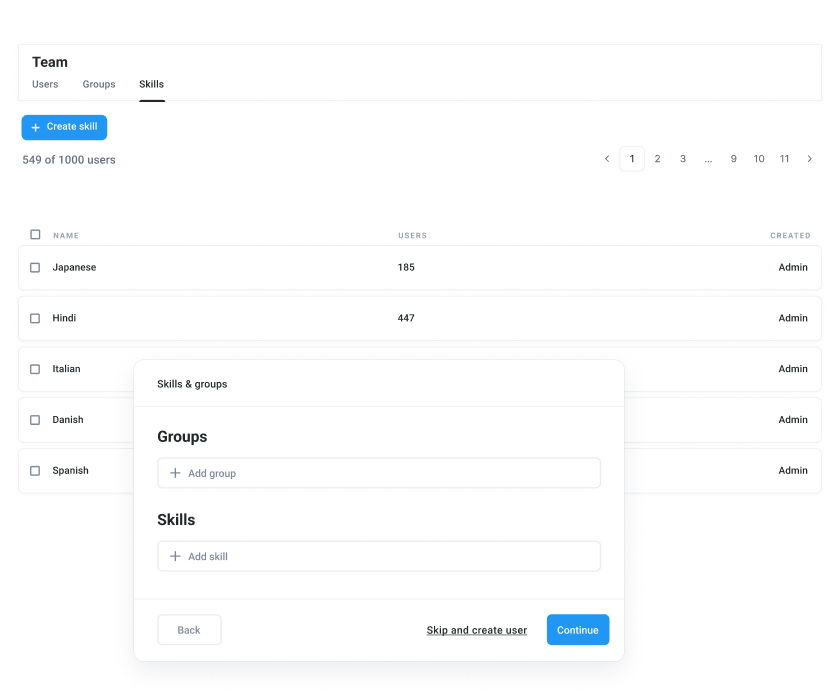
AI-Powered Speech Analytics for Risk Management and Quality Assurance
Insurance call centers manage thousands of sensitive conversations daily, each containing potential compliance risks. Speech analytics transforms these conversations into actionable intelligence.
CloudTalk’s AI suite and call quality management solutions include multiple features to streamline your call center operations, supporting both traditional and IVR-based customer support.
For example, with Call Recording and Call Transcription, conversations are easily searchable and analyzable.
Real-time Sentiment Analysis tracks customer mood, identifying emotionally charged interactions that might indicate escalation risks.
Finally, Topic Extraction identifies recurring themes in customer conversations, helping you refine scripts and address emerging issues.
With speech analytics, your team can pinpoint policy explanation confusion, standardize effective responses, and uncover cross-selling opportunities based on actual customer language.

CRM Integration to Unify Customer Data Without Compliance Gaps
For insurance agencies, disconnected systems create compliance vulnerabilities. CloudTalk’s Integration capabilities allow seamless connection with existing customer management platforms. This creates a unified view of each policyholder without compromising security.
The system syncs customer data, policy information, and interaction history in real-time, providing agents with complete context as calls connect. This eliminates the need for customers to repeat information.
Meanwhile, integration with helpdesk and ticketing systems ensures that follow-up items aren’t lost between departments. This reduces dropped callbacks and incomplete resolutions. By maintaining consistent customer records across platforms, you can demonstrate proper information handling during regulatory audits while delivering more personalized service.
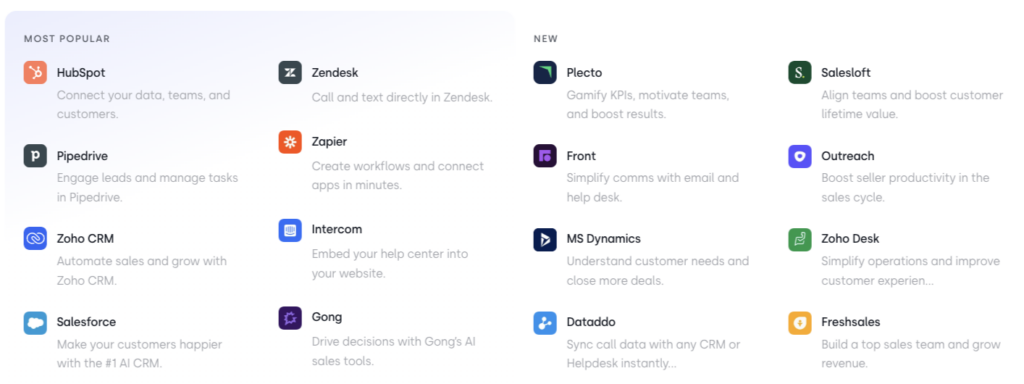
Automated Call Transcriptions and Data Security Measures
Call transcription has become essential for insurance operations, creating searchable documentation while enhancing security protocols.
CloudTalk’s automated Call Transcription converts conversations into text records in multiple languages, providing critical documentation for claims discussions and policy changes.
For quality assurance teams, having text records makes comprehensive review more efficient than re-listening to entire calls.
From a security standpoint, the system offers sensitive data handling features including automatic PII redaction and HIPAA-compliant storage. Insurance agencies can customize security protocols based on call type and content, ensuring proper protection for medical information, payment details, and other sensitive data.By combining advanced transcription with structured security measures, CloudTalk helps you maintain robust compliance documentation while making conversation data more accessible.
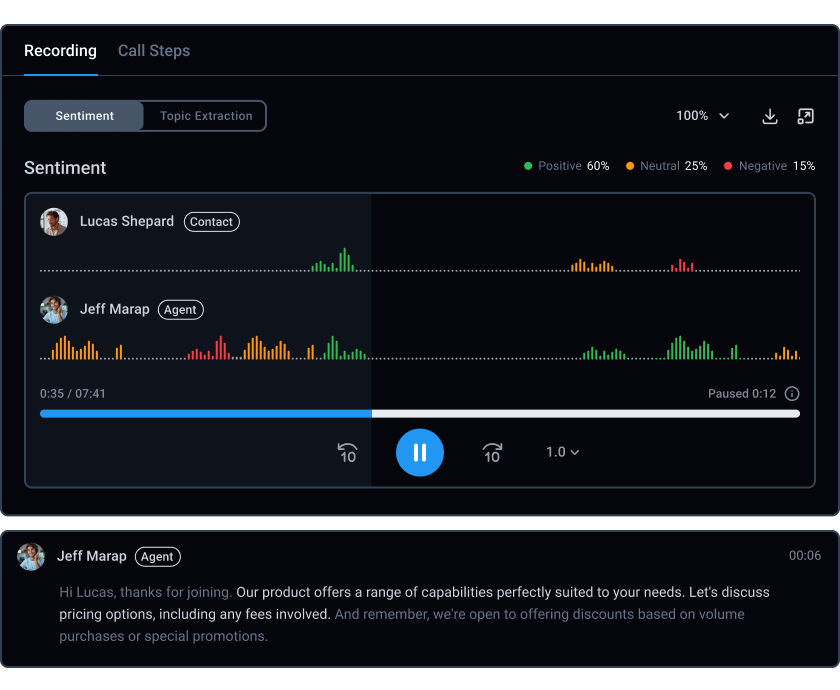
Pro Tip
Pro tip: Create notes during calls and access them anytime to pick up where you left off. Use your conversation history to build stronger customer relationships and improve follow-ups.
Learn more about Call Notes
Selecting the Right Call Center Software to Fix Gaps and Ensure Compliance
Having mapped key gaps and compliance risks, Sarah needed software that could both solve immediate issues and keep the call center compliant as it grew. She focused on two areas when evaluating her options:
Key criteria for choosing the right platform
When comparing options, focus on these core factors:
- Integration: Does it connect with your existing CRM and helpdesk platforms to ensure seamless data flow?
- Compliance: Does it offer built-in features like call encryption, consent management, and audit-friendly reporting?
- Scalability: Can it flex from a small team to enterprise-level operations without requiring a platform switch?
- Pricing flexibility: Does the pricing model allow you to adjust seats month to month as your team size changes, without requiring a long-term commitment for unused seats?
How the right platform addresses core needs
The right call center software doesn’t just meet technical requirements—it solves the operational and compliance challenges you face every day. As you evaluate options, look for solutions that:
- Use Intelligent Call Routing to direct customers to agents based on skills, history, and licensing—essential for insurance scenarios where specialized knowledge is required.
- Provide Call Recording and Call Transcription capabilities to create searchable documentation while maintaining compliance standards.
- Offer Call Notes and CRM Integration to create records of each customer interaction without manual entry.
- Use a Real-Time Dashboard to get real-time visibility into team performance, which helps identify training needs before they affect customer satisfaction.
Note: CloudTalk’s IVR software comes with HIPAA-compliant recording storage, call encryption, and selective recording powered by AI.
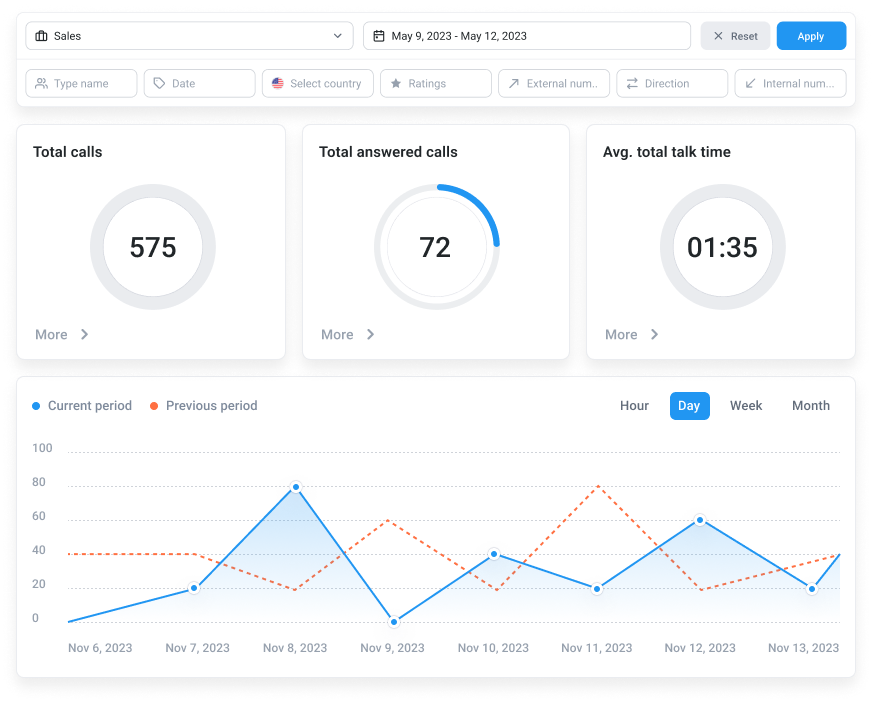
CloudTalk’s flexible pricing plans let you scale your team up or down as needed, so you’re never stuck paying for unused seats.
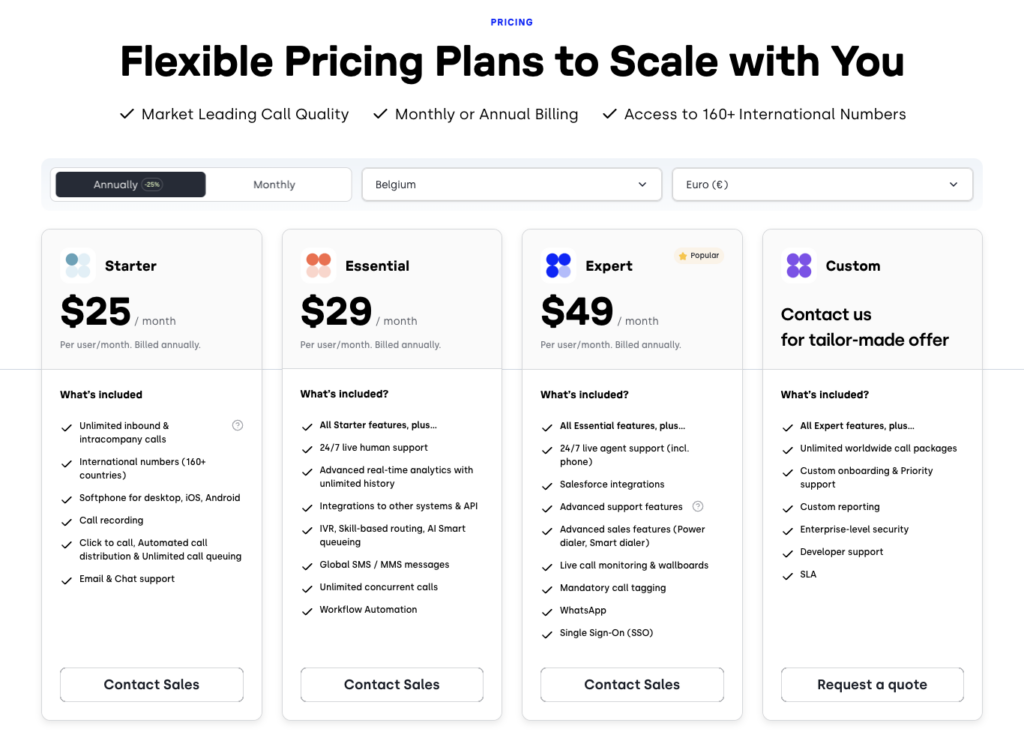
Does Sarah Get The Right Call Center Technology for Improving Service and Efficiency?
Six months after adopting an integrated solution featuring intelligent routing, AI analytics, and compliance safeguards, Sarah’s team performance metrics improved significantly:
- Call wait times decreased
- First-call resolution rates increased
- Agents spent less time on manual administrative tasks
These results mirror real-life successes. For example, Nokia implemented CloudTalk’s analytics and achieved a 10% increase in productivity, handled 38% more calls per month, reduced maximum waiting times by half, and improved customer satisfaction.
When you choose your next platform, focus on solving your critical operational gaps while ensuring compliance—that’s how you get measurable results that actually move the needle.
With the right call center technology, you can turn daily challenges into opportunities for exceptional customer service, operational efficiency, and bulletproof compliance.
Run a smarter call center
Sources:
FAQs about Insurance Agency Call Centers
How Does Call Center Software Improve Customer Retention?
Personalized service with Preferred Agent Routing builds loyalty while reducing resolution times, creating consistent experiences that policyholders value.
What Security Measures Matter Beyond HIPAA Compliance?
STIR/SHAKEN protocols, Single Sign-On, and role-based access controls protect against fraud while maintaining proper data segmentation across departments.
How Do AI and Automation Lower Costs?
In the BPO context, manual tasks like taking Notes, Transcription, and accessing customer data become automated, creating a more cost-effective approach to customer support.
What Are the Challenges of Scaling an Insurance Call Center?
Training consistency, technology integration, and maintaining security become increasingly complex as agencies grow across locations and product lines.














